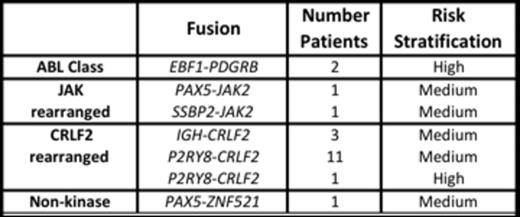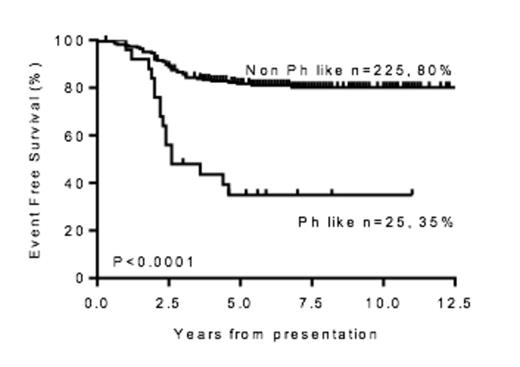Abstract
Introduction:
While remission rates for childhood acute lymphoblastic leukemia (ALL) now exceed 80%, relapsed ALL remains the leading cause of non-traumatic death in children. Recently, a high-risk group of B-progenitor ALL patients has been identified. Such cases exhibit a gene expression profile similar to that of BCR-ABL1 positive (Ph+) ALL but are BCR-ABL1 negative, and also experience poor treatment outcomes. This subset, termed Ph-like ALL, is characterised by a range of genetic alterations that activate cytokine receptor and kinase signalling, allowing potential targeting by available tyrosine kinase inhibitors (TKI). The frequency of Ph-like ALL in the Australian community and the prognosis in the setting of the first MRD (minimal residual disease) intervention trial by the Australian and New Zealand Children's Haematology/Oncology Group (ANZCHOG ALL8) is unknown.
Method:
We retrospectively screened 250 unselected samples that were available from children diagnosed with B-ALL, for Ph-like ALL. The children, aged between 1 and 18 years, were enrolled on the ANZCHOG ALL8 trial and recruited from 2002-2011. The criteria for stratification to the high-risk group, based upon Berlin-Frankfurt-Munster (BFM) protocols, were BCR-ABL1 or MLL t(4;11) translocation; poor prednisolone response at day 8; failure to achieve remission by day 33 or high MRD (>5 x10-4) at day 79. MRD was measured by RQ-PCR for patient-specific immunoglobulin and T-cell receptor rearrangements. All patients received a standard BFM four drug induction chemotherapy regimen including a prednisolone pre-phase and intrathecal methotrexate. High-risk patients received a further three novel intensive blocks of chemotherapy followed by transplant in most cases. Patients were screened for Ph-like ALL using a custom Taqman Low Density Array (TLDA) based upon previous reports. Fusions were then confirmed by RT-PCR for 30 known fusions, Sanger sequencing, mRNA sequencing and/or FISH.
Results:
Ten percent (25/250) of children in this cohort were identified as having Ph-like ALL, with most fusions converging on kinase activating pathways (Table 1). Three Ph-like ALL patients were considered high-risk, the remaining 22 (88%) were medium risk. Five children with Ph-like ALL, that did not have a fusion identified by RT-PCR, are currently under further investigation. Furthermore, 15 of the 20 (75%) of rearrangements involved CRLF2 with 10 (66%) of these children relapsing. Strikingly, 56% (14/25) of children in the ALL8 cohort who were identified as Ph-like subsequently relapsed compared to 16% (36/225) who were not, with significantly worse event free survival (p<0.0001) (Figure 1).
Conclusion:
Here we demonstrate a significantly higher frequency of relapse amongst Australian children with Ph-like ALL compared to non Ph-like disease despite a MRD-adjusted intensification regimen. In this cohort, these children should be classified as high-risk due to high treatment failure rates with standard/medium risk regimens. Importantly, rapid identification of these patients may guide future intervention with targeted therapies, such as TKI, matched to the causative genetic lesion in this high-risk group.
Fusions identified in Ph-like ALL from ANZCHOG ALL8 cohort.
Fusions identified in Ph-like ALL from ANZCHOG ALL8 cohort.
Kaplan-Meier estimates of event free survival for patients with Ph-like ALL and non Ph-like ALL (all risk groups).
Kaplan-Meier estimates of event free survival for patients with Ph-like ALL and non Ph-like ALL (all risk groups).
Hughes:ARIAD: Honoraria, Research Funding; Bristol-Myers Squibb: Honoraria, Research Funding; Novartis: Honoraria, Research Funding. Mullighan:Incyte: Consultancy, Honoraria; Cancer Science Institute: Membership on an entity's Board of Directors or advisory committees; Amgen: Honoraria, Speakers Bureau; Loxo Oncology: Research Funding. White:Novartis: Honoraria, Research Funding; BMS: Honoraria, Research Funding.
Author notes
Asterisk with author names denotes non-ASH members.



This feature is available to Subscribers Only
Sign In or Create an Account Close Modal